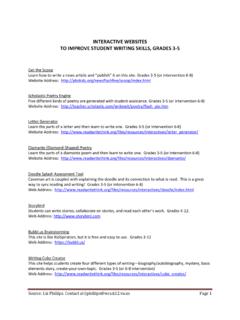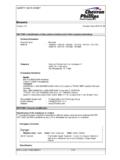Transcription of QDRO'S: WHAT YOU NEED BEFORE YOU DO THE ORDER …
1 1 QDRO'S: what YOU NEED BEFORE YOU DO THE ORDER PHILIP D. phillips Cochran & phillips , 101 W. Randol Mill Rd., Suite 110 Arlington, Texas 76011 Travis County Bar Association Family Law Section Feb. 6, 2002 Austin, Texas 2 I. 1 II. OBTAIN INFORMATION EARLY .. 1 A. Client Information .. 1 B. Plan Summaries and Booklets .. 1 C. Direct Contact With Plan or Employer .. 1 III. WHY DO I NEED A QDRO? .. 2 IV. TYPES OF PLANS .. 2 A. Defined Benefit Plan (DBP)..2 1. 2 2. Examples .. 3 3. No Lump sum or 3 4. Amount of 3 5. Benefit Payment Type ..3 6. Warning - Defined Benefit Plans That Look Like Defined Contribution 3 B.
2 Defined Contribution Plan (DCP) .. 4 1. 4 2. Examples .. 4 3. Lump sum or Cash-out .. 5 4. Amount of 5 5. Increases or Decreases ..5 6. 5 7. Loans .. 5 V. INFORMATION REQUIRED EVEN IF YOU CONTRACT OUT THE QDRO .. 6 VI. what EVERY DECREE SHOULD INCLUDE .. 6 A. All Plan Types .. 6 B. Include for Defined Benefit 7 C. Include for Defined Contribution Plans .. 7 VII. REAL-WORLD EXAMPLES OF what CAN GO 7 VIII. CONCLUSION .. 8 1I. INTRODUCTION This paper is not intended to provide forms or a "how to" in actually drafting a QDRO. There are a number of excellent articles in the Marriage Dissolution and Advanced Family Law Seminar materials over the past several years to guide you.
3 This paper is intended to highlight the basic information and understanding that every family law attorney needs in every divorce case that deals with a retirement, pension, 401k, or similar deferred compensation plan (which I shall refer to in this paper as a "Plan"). Whether you draft the actual QDRO yourself, or contract it out, the divorce lawyer must gather certain information early in the process or risk having major problems develop that can negatively affect your client and your malpractice premiums. II. OBTAIN INFORMATION EARLY Most clients, whether they are the Plan participant or the alternate payee, will be able to tell you, when you are first hired for the divorce, whether or not a pension, retirement, 401k or similar plan exists.
4 They may not know much about the Plan, but most are aware of its existence. Unless the parties have already agreed to not divide such plans, or each have plans that are similar in value, the attorney should, from the beginning of the case, gather basic information about the existence and nature of any deferred compensation plans. Your client is going to ask, at some point, what he or she can expect to receive from the spouse s Plan upon divorce. In ORDER to answer, you must be somewhat familiar with the Plan. Further, you can't proceed to mediate or negotiate a settlement without a basic understanding of the value, type and workings of the Plan.
5 It is not that rare that a settlement is made involving a Plan, only to discover, after the case is finalized, that the division will not work as planned or can't be done at all. Judges will normally be relying on you for adequate information on the Plan at trial in ORDER to make a fair and valid division. Making a error as to the division of a Plan, especially when it is a major asset of the community estate, can be devastating to your client and is preventable. The various formal discovery methods that can be used to gather information are beyond the scope of this paper, however the following informal methods can routinely be used.
6 A. Client Information When you initially review the assets of the estate and your client's expectations of its division, find out if a deferred compensation plan does or could exist. Always, always be cautious about the information you receive. Participants may not know much or may purposefully fail to mention one of the plans, while identifying others. Spouses may have little information, be unaware of recent, significant Plan changes, or not be aware of all the Plans the participant is in.
7 Client information is only a start. B. Plan Summaries and Booklets Almost all Plans will provide the participant with a summary of the Plan. A copy of the actual Plan document can be obtained, but it is too complicated and not really necessary. A Plan summary packet or booklet will usually identify all the Plans in which an employee may participate, the proper Plan names, Administrator name, phone and address, type of Plan and a simplified summary of the terms of the Plan. Most Plan summaries also contain a section on QDROs and Alternate Payees and may provide some important information on this aspect.
8 If you can't obtain a Plan summary from your client or the opposing party directly, contact the Plan or employer. Many will provide you or your client with a summary, although some will refuse without a signed release from the participant or a subpoena. The attitude and cooperative nature of the Plans vary widely. The Office of Personnel Management (OPM) supplies excellent booklets and sample language for the unique features of the federal Civil Service Retirement System, Federal Retirement System and Thrift Savings Plans, although they are not casual reading.
9 C. Direct Contact With Plan or Employer Whether or not you have a Plan summary, the next step is usually to phone the Plan Administrator or the Employer and ask some basic questions. Again, the Plan may or may not be cooperative, but it never hurts to ask. Generally, if you phrase your questions as 2hypothetical, or only seek general Plan information, most will help you. Specific information about a particular participant will almost always require a signed release, but again, it never hurts to ask.
10 Some Plans will not give you specific information on the account, such as a current balance or benefit, but may tell you whether or not the employee participates in certain Plans. This is helpful if you have reason to believe there are some unidentified Plans in the case. If you prepare QDROs routinely, you will come across small Plans that have never had to deal with a QDRO, even though QDROs have existed for more than 16 years. Find out now, not after the divorce is concluded, since there can be a long learning period for the Plan, which can delay the approval of a QDRO.







